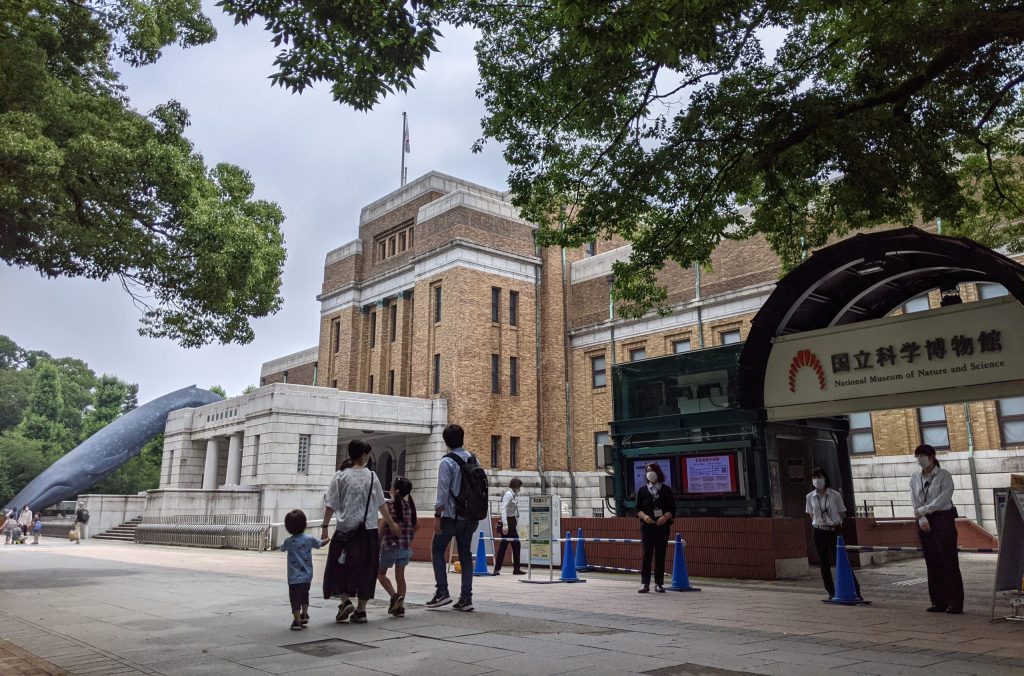
March 31, 2022
New Technologies that Lead the National Museum of Nature and Science into the Future under COVID-19 Pandemic
[2022.3.31]
Atsushi YABE, Senior Curator
Department of Geology and Paleontology,
National Museum of Nature and Science
More than two years have passed since the novel coronavirus began to spread in Japan. Since the first state of emergency was concurrently instated with the initial wave of cases, we have overcome many waves thereafter and accumulated experience along the way. I believe that all museums have the capacity to continue their operations while coexisting with coronavirus without completely closing their exhibition spaces. From a researcher’s standpoint, this article will present some examples that the National Museum of Nature and Science (NMNS) experienced, particularly some of the new (albeit common!) projects developed through technology.
About the National Museum of Nature and Science
NMNS is the only national museum of natural sciences in Japan and has a history of almost 150 years since its opening in 1877. The museum has five departments consisting of Zoology, Botany, Geology and Paleontology, Anthropology and Science and Technology. Our mission is to assemble and inherit a “national collection” through research in each department, collecting and preserving specimens while disseminating nature and science through exhibitions and educational programs. Like many “national museums,” most of our operating funds come from government grants. However, since becoming an independent administrative institution in 2001, NMNS has been strongly urged to increase its income from admission fees and other sources.
In addition to the main exhibition space in “Ueno District” (Ueno Park, Taito-ku, Tokyo), NMNS has two other satellites. “Institute for Nature Study,” located in Shirokanedai, Minato-ku, Tokyo, is a semi-natural forested area that has inherited a garden dating back to the 17th century and is an oasis of greenery in the city (Image 1). “Tsukuba District,” located 50 km northeast of Ueno District, in Tsukuba Science City, Ibaraki Prefecture, consists of the Tsukuba Botanical Garden and the Tsukuba Research Departments (Image 2). A majority of the museum’s 60+ full-time research staff reside in the Tsukuba area, and our collections are preserved and managed in a storage facility in the same area. Various projects of NMNS are managed and implemented in cooperation with each other while being geographically separated from the Ueno District who oversees the museum management. Each district has a unique situation; therefore, the response to the pandemic has been inevitably location-specific.
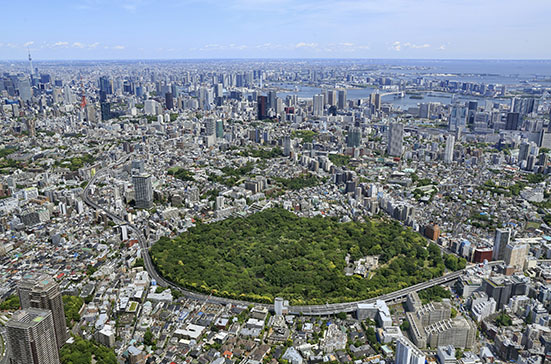
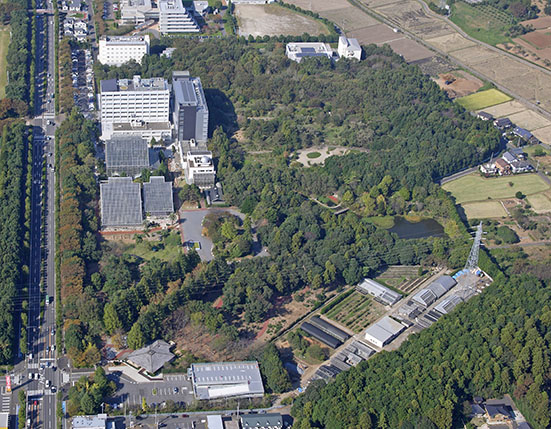
The National Museum of Nature and Science: Initial Response to the Pandemic
Japan confirmed the first case of the infection in early January 2020, and by February, the coronavirus had spread nationwide. NMNS temporarily closed three facilities from February 29, at the request of the Minister of Education, Culture, Sports, Science and Technology. The Ueno District reopened on June 1, and the Tsukuba Botanical Garden and the Institute for Nature Study, which is mainly outdoors, were among the first to reopen on March 25. However, the regions under the state of emergency expanded, and Tsukuba Botanical Garden was temporarily closed from April 14 to May 17, and the Institute for Nature Study from March 28 to May 31. The museum’s “Special Exhibitions” jointly organized by cooperating corporations and independently funded “Planned Exhibitions,” both came to an untimely end due to the state of emergency, and several scheduled exhibitions to follow were postponed or canceled.
The Ueno District has implemented admission restrictions based on advance reservations, while the other two facilities have administered temperature inspections and disinfection which resulted in the facilities remaining open without temporary closures since its reopening. The museum has made improvements such as introducing a service that allows visitors to view exhibition details on their smartphone device; however, facilities/equipment and visitor services considered to have a relatively high risk of infection remain suspended as of March 2022. Popular areas such as the “ComPaSS —Exploration area for families with children,” a hands-on learning experience for children under elementary school age and their parents or guardians, and the “Touch and Talk Wagon” program administered by volunteers were a few that were suspended. These partial closures and admission restrictions have a significant ongoing impact on the “management” of NMNS.
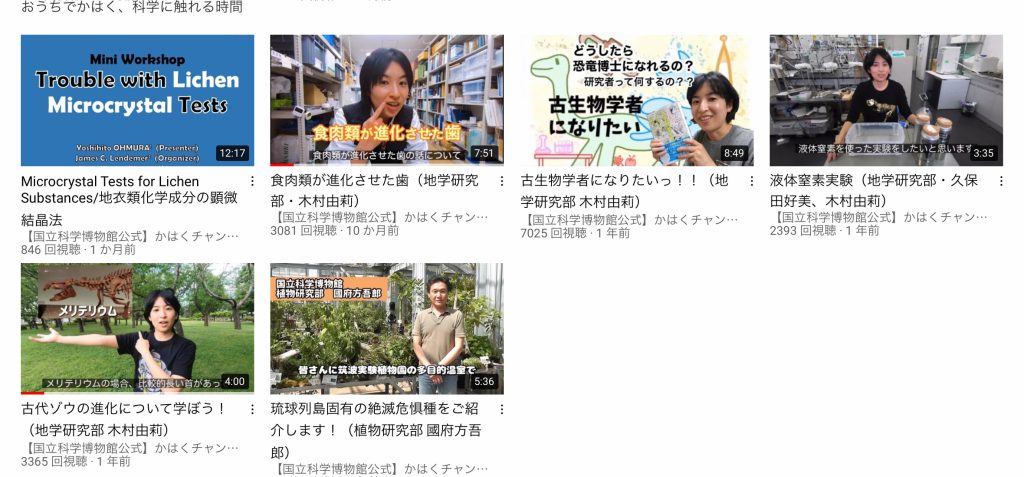
Advancement of Online Technology
I can still recall the impact of the first state of emergency and the tension and stagnation that had seemingly enveloped society as a whole. Just before the declaration was issued, the Public Relations Division called for the creation of video content that could be enjoyed at home and messages of hope for future reunions, and the research staff, including myself, worked remotely under the emergency declaration to create video content. With the cooperation of the public relations staff, we were able to upload them onto the museum’s YouTube channel (Kahaku Channel). The program, titled “Kahaku at Home, coming in contact with science,” has 29 titles to date with engaging behind-the-scenes content of NMNS’s research and specimen collection management (Image 3). Utilizing YouTube and SNS to promote our museum had been under preparation since before the pandemic but only took precedence and priority since the pandemic struck and was immediately shared with the entire museum. Due to the rise of YouTube and other media becoming one of the essential pillars of the museum’s public relations activities, additional contents were created following “Kahaku at Home.”
Virtualization and Progression of Exhibitions
Soon after the pandemic, the public relations staff at NMNS took the initiative to convert the permanent exhibits to virtual reality (VR)(Image 4). A 360-degree camera captured high-definition images to reproduce virtual three-dimensional exhibition spaces to give visitors a realistic experience as if they were inside the exhibition rooms. As intended, the system allowed users to enjoy the exhibition’s atmosphere and learn from the exhibition panels and specimens through incredibly clear and distortion-free images. We also created video content to introduce ways to enjoy the exhibit using VR for the visitors who could not come due to the closures and travel restrictions.
Several of the planned exhibitions were converted to VR subsequently. The museum conventionally overlooked visitors who could not visit the exhibition in person, but the VR exhibitions and “informational videos” that we created synchronously would give them an opportunity to look back and “experience” them.
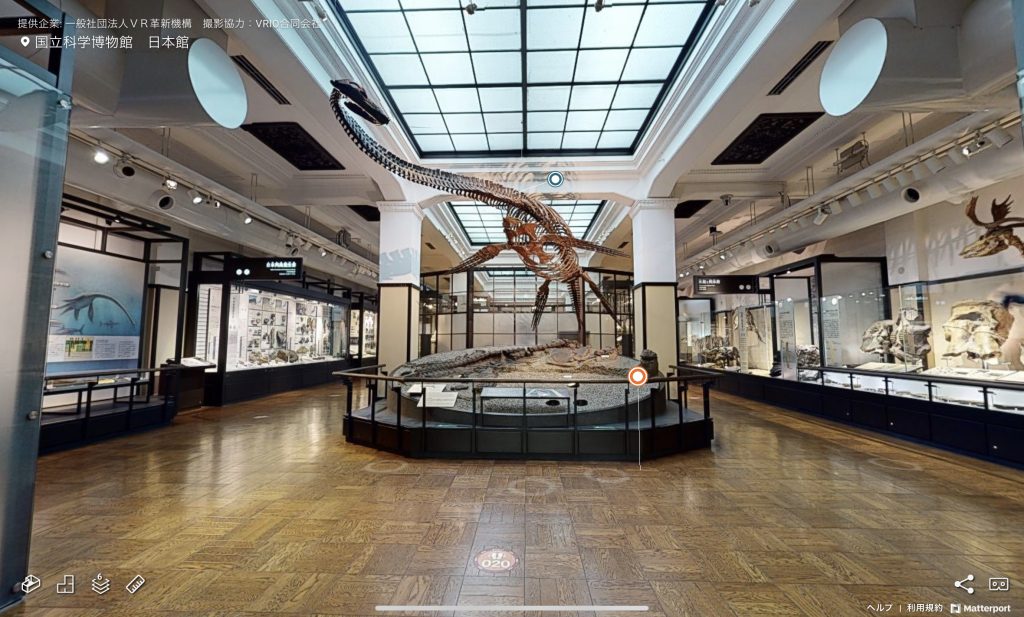
Special Exhibitions: Impact and New Developments
The coronavirus impacted human movements domestically as well as our interactions across international borders. NMNS oftentimes borrowed important specimens from overseas museums to display in our Special Exhibition, but such projects became difficult to carry out. In this case, we canceled our plans to loan specimens from overseas and modified them to exhibit only domestic specimens.
The exhibition I served as partial supervisor, “Plants—Mainstay of the Planet” (July 10-September 20, 2021), had initially planned on exhibiting loaned specimens from overseas museums, most of which did not come to fruition. The only loaned specimen was a fossil from the National Museum, Prague, Czech Republic. When specimens are loaned from foreign museums, it is customary for the local museum staff to set up the exhibition. However, for this particular specimen, the contract included a condition that an attendant will provide online supervision if they could not be present due to the spread of the coronavirus. Since overseas travel restrictions were in place during the setup and removal timeframe at the Ueno District, we set up an online meeting via Zoom so the overseas research staff could monitor the entire process (Image 5).
Perhaps the National Museum, Prague, Czech Republic, were empathetic under the same distressing circumstance of the pandemic when they agreed to such an irregular proposal. Regardless, we were able to adopt online technology at this opportunity. Furthermore, with online technology, we were able to flexibly conduct other exhibition-related events without conforming to the limits of “distance” or “time.”
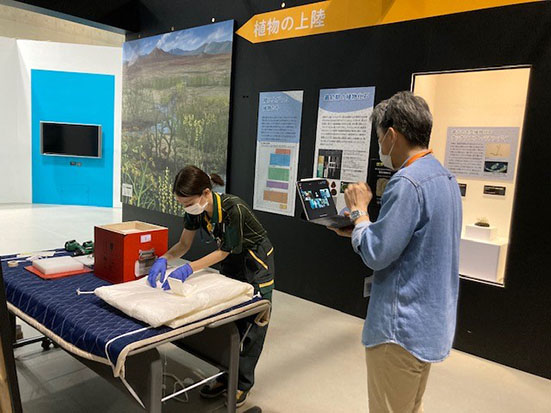
Impact on Specimen Collection and Research
Let us examine the impact on research, which is the pillar of NMNS. In the Tsukuba District, researchers generally work in private rooms with only a few other workers, so they were able to carry on as usual by taking basic infection control measures. However, activities outside the museum have been affected, such as collecting new specimens. In particular, we have not been able to conduct overseas research. For the time being, all we can do is review and culminate the materials that we have previously collected. However, this may affect future exhibitions and educational programs in the long run.
Barring the declaration of the state of emergency in Ibaraki Prefecture, Tsukuba District allows the entry of researchers and visitors, but annual users decreased to about 45% last year. In particular, the inability of overseas researchers to visit the center due to travel restrictions has had a significant hindrance to their research progress.
Concerns Over Educational Programs
Educational programs at NMNS include Discovery Talks, Natural History Seminars, and Nature Walks to introduce exhibitions and research activities at the Ueno District. The wide range of specialties of the researchers provides colorful and varied content and has been one of the attractions of NMNS activities. However, it has not been easy to implement many of those programs. Now, Discovery Talks occur in an auditorium that can accommodate many people while limiting the number of participants to avoid close-range interaction. Also, the number of scheduled events decreased to half to conduct proper ventilation. On the other hand, lectures involving face-to-face practical training, such as Natural History Seminars and Nature Walks, have not resumed. The Natural History Seminars for university and graduate students train successors in each department, and Nature Walks provide a valuable opportunity for students to interact directly with experts in various fields and experience natural science that is not available in a school education environment. If these programs cease to resume, there may be sequential ramifications in the future.
Under these circumstances, a program has begun at the Tsukuba Botanical Garden using ICT (Information and Communication Technology) to provide field exhibitions and hands-on training so that researchers and participants can interact with each other. According to the researcher in charge of the program, the interaction contributes to the satisfaction of the participants and feeds back to the researcher. We have high hopes that experiences such as this and the implementation of techniques will be applied to other educational programs in the future at NMNS.
Conclusion
“Coexisting” with coronavirus will likely continue for the seeable future. However, what we experienced through the past two years positively ameliorated the museum’s activities, bringing them back to their intended purpose. Some projects have seemingly progressed even further than before. We will keep making efforts to sustain these activities and tackle unsolved issues.
While preparing for this article, researchers from overseas contacted me consecutively, discussing how they would like to come to Japan this fall to see the specimens. What an emotional moment to know we are moving forward toward normalcy, and I will strive to carry out the research-centered mission of the Museum.
(Atsushi YABE)